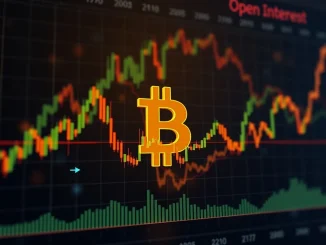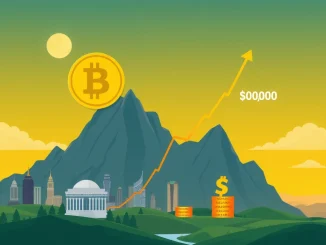
Bitcoin’s journey is rarely straightforward. While the **Bitcoin price** recently reached a significant 10-week high, hitting levels around $97,930, a closer look beneath the surface reveals a more complex picture. Despite the upward movement, the overall **Bitcoin market sentiment**, as indicated by key derivatives data, remains surprisingly neutral. This presents a puzzle for investors: why isn’t a strong price rally translating into widespread bullishness?
Unpacking the Recent **Bitcoin Price** Surge
Let’s acknowledge the positive first. Bitcoin’s climb to nearly $98,000 marks a notable achievement, representing its highest point in 10 weeks. This kind of price action typically generates excitement and anticipation within the crypto community. A rising price often fuels optimism, leading many to expect further gains. However, market dynamics are influenced by more than just price charts.
Decoding **Bitcoin Market Sentiment** Through Derivatives
To understand the underlying mood of the market, analysts often turn to derivatives data. One key indicator is the annualized premium on Bitcoin futures contracts, particularly those with shorter durations like two months. Here’s what the data is currently telling us:
- The annualized premium on two-month Bitcoin futures has been hovering between 6% and 7%.
- This range is generally considered neutral. It suggests neither excessive bullish speculation (which drives premiums higher) nor significant bearish hedging (which can push premiums lower or even negative).
- This contrasts sharply with earlier periods, such as January, when Bitcoin was trading near $95,000. At that time, futures premiums topped 10%, clearly reflecting stronger positive sentiment among traders.
The current data indicates that while the spot price has risen, the conviction among derivatives traders is not as strong as it has been during previous price peaks. This neutral stance in the derivatives market acts as a significant counterpoint to the headline-grabbing price increase.
How **Macroeconomic Factors** Are Shaping Crypto
A major reason for the subdued sentiment, despite the price rally, lies in the broader economic landscape. Global **macroeconomic factors** are playing an increasingly influential role in the cryptocurrency market. Specifically, ongoing tensions between the U.S. and China are cited as a key concern. These geopolitical and economic pressures can ripple through traditional financial markets, and consequently, impact assets like Bitcoin.
There’s a growing observation that Bitcoin’s price movements have started to mirror those of traditional indices, such as the S&P 500. If these macro pressures persist, this correlation could strengthen. This linkage means that negative developments in the global economy or stock markets could potentially drag Bitcoin down, regardless of its internal network fundamentals or adoption trends.
Is **Bitcoin Digital Gold** Still the Narrative?
For years, a core part of the investment thesis for Bitcoin has been its potential role as “digital gold.” This concept positions Bitcoin as a store of value, an asset that holds its purchasing power over time and, crucially, is uncorrelated with traditional financial markets. The idea is that during times of economic uncertainty or inflation, investors might flock to Bitcoin as a safe haven, much like they would to physical gold.
However, the observed correlation between Bitcoin and the S&P 500 raises questions about this “digital gold” narrative. If Bitcoin is moving in tandem with the stock market, it weakens its appeal as a truly uncorrelated safe haven asset. Investors who bought Bitcoin specifically for its diversification benefits might become concerned if it behaves more like a risk-on tech stock than a stable store of value during turbulent times.
Navigating Mixed Signals and the Near-Term Outlook
The current market presents investors with a mix of signals:
- Positive: A strong price increase to a multi-week high.
- Neutral/Cautious: Derivatives data indicates neutral sentiment, lacking the strong bullish conviction seen previously.
- Challenge: Macroeconomic factors, particularly U.S.-China tensions, introduce external risk.
- Concern: Increasing correlation with the S&P 500 challenges the “digital gold” narrative.
- Slightly Bullish Lean: Despite overall neutrality, derivatives data isn’t outright bearish and shows a slight tilt towards bullishness, suggesting potential for limited near-term upside if macro conditions don’t deteriorate significantly.
Understanding this confluence of factors is crucial for anyone engaged in **crypto market analysis**. While the price rise is encouraging, the lingering macroeconomic concerns and the observed correlation with traditional markets temper the overall optimism. This scenario highlights the increasing maturity and integration of the crypto market into the broader financial system.
Summary: Price Up, Guard Up
In conclusion, Bitcoin’s recent price surge to a 10-week high is a positive development on the surface. However, digging into the **Bitcoin market sentiment** through derivatives reveals a more cautious stance. This neutrality is heavily influenced by external **macroeconomic factors**, like U.S.-China trade tensions, which are also contributing to Bitcoin’s correlation with traditional markets like the S&P 500. This correlation, in turn, puts pressure on the long-held belief in **Bitcoin digital gold** as a completely uncorrelated asset. While the immediate outlook from derivatives has a slight bullish lean, the overarching macro environment suggests investors should remain attentive to global economic signals. The current state of the market is a reminder that while crypto has unique drivers, it is not immune to the forces shaping the global economy.



